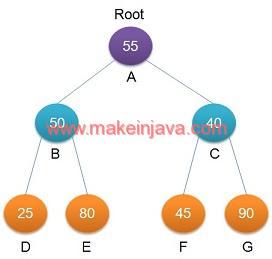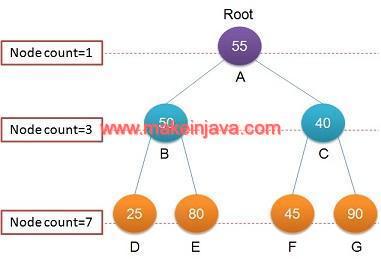- Given a binary tree, count number of nodes using non recursive algorithm.
- We will calculate size of binary tree using breadth first search (bfs) or level order traversal algorithm.
- During binary tree traversal, we will keep on adding the number of elements at each level.
- At end of traversal, we will get number of nodes in a binary tree.

Algorithm: count number of nodes in a binary tree using java(Fig 1)
- Create local variable nNodes (signify the node count)
- nNodes initialized to 0
- Visit the Level 0
- visit all nodes in Level 0 and found only node A
- nNodes increment by 1 [nNodes = 1]
- Go to Level 1 and visit all nodes in Level 1
- Found node B, nNodes increment by 1 [nNodes = 2]
- Found node C, nNodes increment by 1 [nNodes = 3]
- Go to Level 2 and visit all nodes in Level 2
- Found node D, nNodes increment by 1 [nNodes = 4]
- Found node E, nNodes increment by 1 [nNodes = 5]
- Found node F, nNodes increment by 1 [nNodes = 6]
- Found node G, nNodes increment by 1 [nNodes = 7]
- Visited all nodes in binary tree [Refer Fig 2]

The time complexity of algorithm is O(n).
Program – number of nodes or size of a binary tree using java (BFS)
1.) CountNodes Class:
- Find number of nodes or size of a binary tree.
- Traverse binary tree using level order traversal.
package org.learn.Question;import java.util.LinkedList;import java.util.Queue;public class CountNodes { public static int countNodes(Node root) { if (root == null) { System.out.println("Tree is empty"); return -1; } int nNodes = 0; Queue<Node> queue = new LinkedList<Node>(); queue.offer(root); while (!queue.isEmpty()) { Node node = queue.poll(); if (node.left != null) { queue.offer(node.left); } if (node.right != null) { queue.offer(node.right); } nNodes++; } System.out.println("Number of nodes in a binary tree : " + nNodes); return nNodes; }} |
2.) Node Class:
- Node class is representing the nodes of a binary tree.
package org.learn.Question;public class Node { public int data; public Node left; public Node right; public Node(int num) { this.data = num; this.left = null; this.right = null; } public Node() { this.left = null; this.right = null; } public static Node createNode(int number) { return new Node(number); }} |
3.) App Class:
- We are creating a binary tree in main method
- We are calling method of CountNodes class, to find number of nodes in a binary tree.
package org.learn.Client;import org.learn.Question.CountNodes;import org.learn.Question.Node;public class App { public static void main(String[] args) { // root level 0 Node A = Node.createNode(55); // Level 1 Node B = Node.createNode(50); Node C = Node.createNode(40); // Level 2 Node D = Node.createNode(25); Node E = Node.createNode(80); Node F = Node.createNode(45); Node G = Node.createNode(90); // connect Level 0 and 1 A.left = B; A.right = C; // connect level 1 and level 2 B.left = D; B.right = E; C.left = F; C.right = G; CountNodes.countNodes(A); }} |
Output – Size of binary tree using level order traversal using java
Number of nodes in a binary tree : 7 |
Download code – size of binary tree non recursive algorithm in java
